London Oxford - the First Black Settler in the Ottawa Valley
- Rick Henderson

- Feb 17, 2023
- 7 min read
Updated: Apr 4, 2024
In recognition of Black history month.

LONDON OXFORD, most often described in official documents as "a person of colour", had the distinction of being the first black settler in the Ottawa Valley.
He arrived here in 1800, travelling from his hometown of Woburn, Massachusetts with Philemon Wright, the founder of the first permanent colonial settlement, accompanied by Philemon's wife Abigail, her sisters, Margery and Lavina, and Philemon's brother, Thomas. [1]
London's life in Woburn
IN a seminar entitled "The Famous Township of Hull" [2], Dr. Bruce S. Elliott was the first to introduce us to London Oxford. In his article, Dr. Elliott writes:
"It is known that five families came but the fifth has heretofore been unidentified. It was probably that of London Oxford, a free Negro who had married in Woburn. He probably brought his family with him when he came in 1800, for he had children born in (the Township of) Hull before the family left the area sometime after 1809."

There is not a great deal known about London's life back in Woburn but records tell us that he was a free man who did business with Philemon and that he was a widower. We know that he is a free man because as a witness, he signs by his own hand a document of sale in Woburn, a purchase of thirty acres of land by Philemon Wright, his wife Abigail and her sister, Margery Wyman. Slaves did not sign legal papers as witnesses.
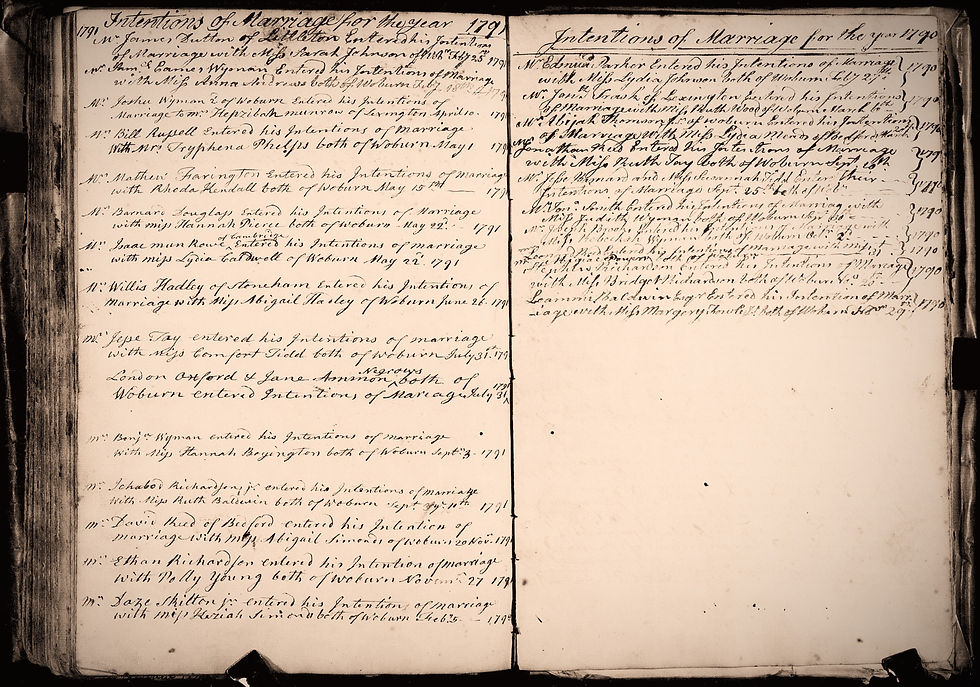
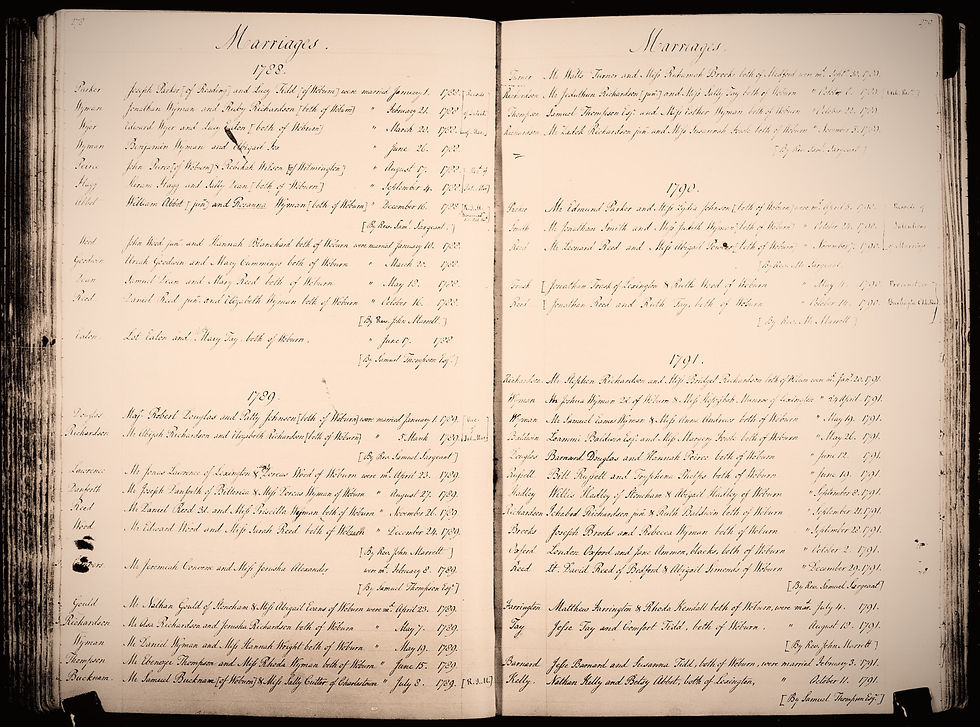
There are two additional records: the statement of London's intention to marry Jane Ammon in Woburn dated July 31, 1791, and the record of marriage on Oct. 2 of that same year. [3]
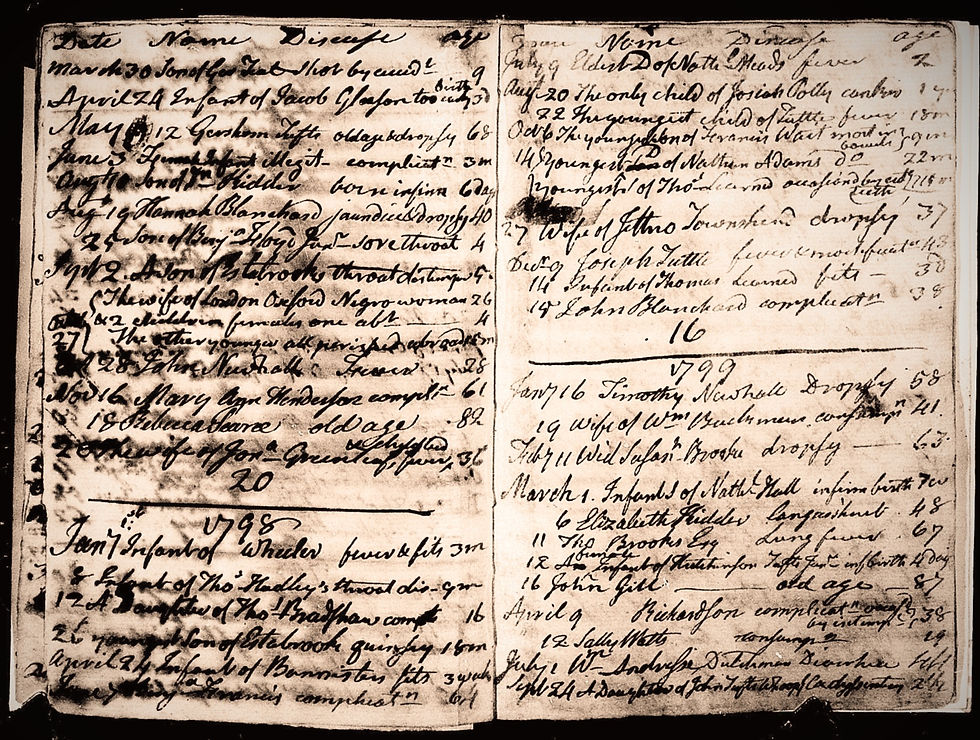
Finally, there is a record of the registration of the death of Jane Ammon on Oct 27, 1797. The record states:
"The wife of London Oxford Negro woman 26 & two children females abt. 4 the other younger all perished abroad." [4]

In another register that is typed and published in a book, there is the following transcription:
"The wife of London Oxford Negro woman" "perished abroad" buried] Oct. 27, 1797, a. 26, C.R.I. ["was found Dead , suposed (sic) to have perished in a storm " P.R.3.] [5]
There is a problem with this record however, in that none of this record agrees with the original, handwritten record that is only about London Oxford's wife and daughters.
The descriptions in four consecutive entries of that book seem to be saying that the cause of Jane Ammon's death is "perishing in a storm" when the original entry says no such thing - only that she "dies abroad" with her daughters. Another entry says that London perished in a storm as well, but on a different date than Jane. To bring complete confusion to it all, one entry says a man named Oxford, dies on another different date in 1795.
We know London Oxford did not die in 1795 or 1797 so, who is the other London? This typed transcription's accuracy about London and his wife is conflicting and confusing and as such, must be questioned about its accuracy.
Three Londons
IN MEDFORD, MA, records show that Col. Royall of Medford owned a slave named "London, A Negro Man of the Widow Mary Bradshaw's Died Oct. 15, 1760". [6],[7]
Another record shows a slave of Thomas Brooks Esq. was named London, and he is quite possibly the London that died on Oct 25, 1797. [8]
So, it appears that there may have been at least three Londons in Middlesex county: London Oxford of Woburn, who was a free man; Thomas Brooks' slave, named London; and Col. Royall's slave of the same name.
Might London Oxford of Woburn have been a grandson of Col. Royall's slave and/or the son of Thomas Brooks' slave, both named London ? There is no way to know, except that around the time that London Oxford is likely born, the Constitution of Massachusetts was adopted, and it states: "it is declared that ‘all men are born free and equal. This was the doom of slavery; and the interpretation of this clause in the case of Commonwealth v. Jennison settled finally the freedom of the negro in this State." [7] That certainly might account for the fact that such unusual names are carried by three men in the same county.
So, according to all this information, the "free man of colour" who arrives in the Township of Hull with Philemon in 1800 is London Oxford, possibly accompanied by his second wife. He is the only man among the first settler families that was not a member of Philemon's family [9]. It can be a safe assumption that London Oxford was a very close associate of Philemon Wright and family.
London Oxford - first Raftsman
SOON after the survey of the Township was completed in 1802, Philemon assigns grants to his associates and London is granted one of the choicest lots of land to be had, Lot 27 in the Long Point Range of Templeton: 200 acres at the mouth of the Gatineau River, including both south and north shores.
London's property also made him Philemon and Gideon Olmstead's [10] (lot 28) neighbour and in four short years, his land would be the scene of a truly historic event, one that marked the beginning of the Ottawa Valley timber industry.
After clearing several farms, and having very successful harvests, Philemon quickly understood the difficulty of getting his crops to market, so by 1805, Philemon devised the audacious plan to float huge rafts down the Ottawa. The rafts would carry his crops and potash as well as bring the timber that had accumulated from clearing the farms to market.

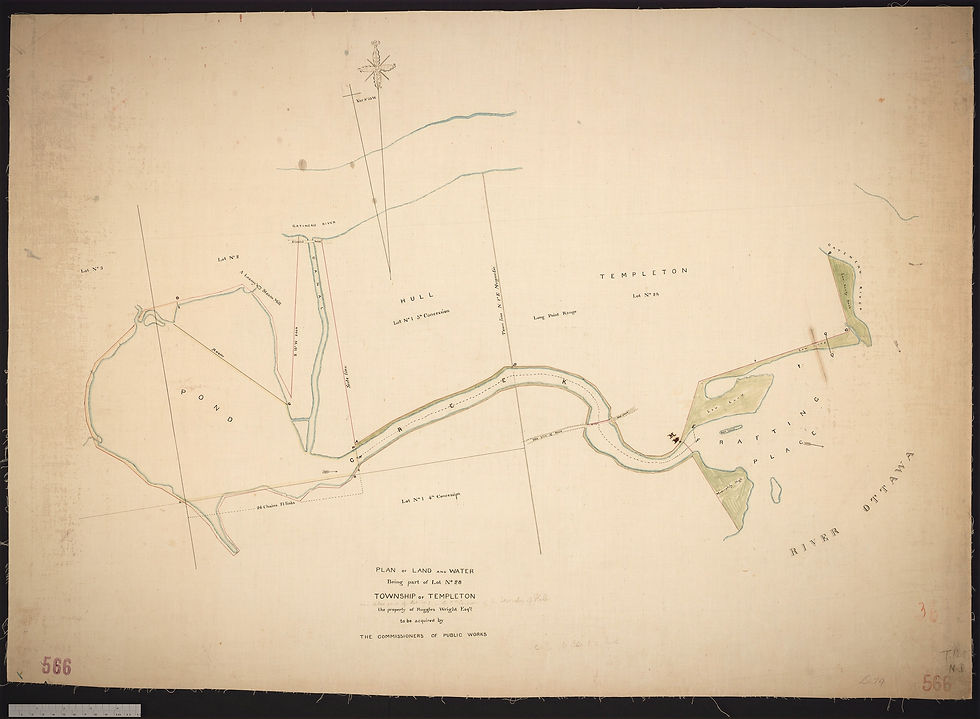
On June 11, 1806, the first square timber raft was sent down the Ottawa River to Quebec [11]. It was launched from the confluence of the Gatineau and Ottawa rivers in a place thereafter called the Rafting Place and given the size of a square timber raft, it had to have been assembled in the location where it was to be launched. The Rafting Place was directly in front of London Oxford and Gideon's properties.

Preparations for building the raft began in early 1805 - long before the Napoleonic blockade - with two contracts drawn up to hire the associates who would get that done. [For more on this see this blog.] London Oxford and Gideon Olmstead's names appear on both contracts. Thousands of oak staves and planks would be prepared at Wright's sawmill and transported to the Rafting Place when they were ready to float the massive raft to the Québec market - Québec City was the destination because a better market price for timber was offered to Philemon than anything he could get in Montreal.
Gideon was a carpenter who built Philemon's first mills, so it was natural that he would have a hand in building that first raft, but might London have been a carpenter as well? It is to be considered, given London's prominence in the settlers' migration in 1800 and the preparations of the raft, in 1805.

Philemon chose four men to accompany him on that maiden voyage of the first raft: his 17-yr-old son, Tiberius, London Oxford, Martin Ebert and John Turner - these were the first Raftsmen of the Ottawa Valley.
London's disappearance in history
AFTER that first journey down the river, London purchases more property in the Township of Templeton - Lots 22 and 9 in the first range - bringing his total to 650 acres, making him one of the largest property owners in the settlement, next to the Wrights. But apart from one more mention, he then disappears from the records.
There is no more mention of him in the Wright Papers, nor is there any record of birth of a child, departure from the Valley or death. We know only that he does leave the Valley and conveys his land back to Philemon in 1809. There is also no trace of where he decided to go.
Philemon Wright will be remembered for many years to come because of the indelible mark he left in Ottawa Valley history but Philemon could not have done any of it without the help of others who must also be remembered. They helped carve out a settlement from the wilderness and start the industry that powered Canada's industrial era, the timber industry. Among the men who must be remembered is the first black settler of the Ottawa Valley, London Oxford.
[1] Here is the list of the five families that arrived to settle here in 1800:
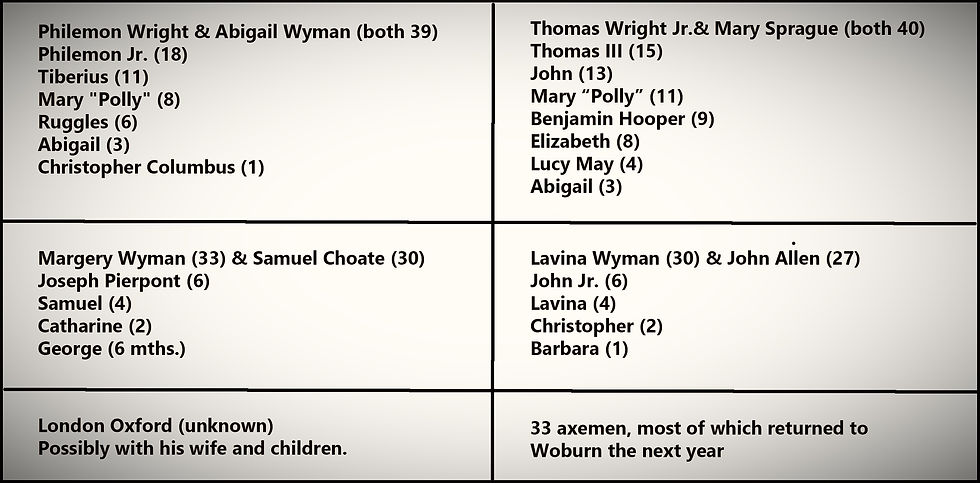
[2] "The Famous Township of Hull": Image and Aspirations of a Pioneer Community*, Dr. Bruce S. Elliott, A seminar in social history, Carleton University.
[3] Massachusetts, Town Clerk, Vital and Town Records, 1626-2001.
[4] Massachusetts, Town Clerk, Vital and Town Records, 1626-2001.
[5] Massachusetts, Compiled Birth, Marriage and Death Records 1700-1850
[6] Enslaved People in Medford, Medford Historical Society & Museum: https://www.medfordhistorical.org/medford-history/africa-to-medford/slavery-in-medford/
[7] Medford Historical Society Papers, Volume 2, Medford Historical Society & Museum: http://www.perseus.tufts.edu/hopper/text?doc=Perseus%3Atext%3A2005.05.0003%3Achapter%3D11
[8] "The Brooks Estate encompasses centuries of Medford history. The original 400 acres were acquired by John Brooks in 1660. The Brooks farmed and fought in the American Revolution. They were also slaveholders." https://brooksestate.org/history/
[9] The four families who arrived here with Philemon were accompanied by 25 or 33 men (it differs in Philemon's own accounts) but most, if not all of them, returned to Woburn in the first year. Some, like Harvey Parker, Daniel Wyman, Martin Ebert and John Turner, seem to have returned with their wives and families the next year or soon after.
[10] Gideon Olmstead would play major roles in the settlement's early history as builder of the mills, likely one of the builders of the first raft, and later, as a justice of the peace, and as commander of the Hull militia. Philemon Jr. would marry his daughter, Sally, and in 1822, Gideon would donate land to create the Olmstead (Bellevue) Cemetery in Aylmer.
[11] Many historians have written that the first raft was given the name Columbo by Philemon. In all the research I have done, I have not been able to find any source for that claim, nor is there one given in other accounts from historians.




So fascinating...as a genealogist I love all those records, even if they contain contradictory information...